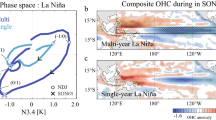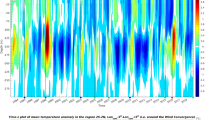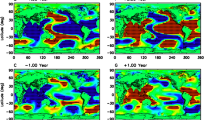Abstract
The El Niño/Southern Oscillation (ENSO) is characterized by two main states: El Niño events defined by positive sea surface temperature anomalies in the eastern tropical Pacific Ocean and La Niña events marked by cooler surface temperatures in the same region. ENSO is broadly considered to be an oscillatory instability of the coupled ocean–atmosphere system in the tropical Pacific1,2,3,4,5,6 that shows a tight interaction with the seasonal cycle. El Niño events typically peak in the boreal winter, but the mechanism governing this phase synchronization7 is unclear. Here we show, using observational data and climate model experiments, that the nonlinear atmospheric response to combined seasonal and inter-annual sea surface temperature changes gives rise to a near-annual combination climate mode with periods of 10 and 15 months. Specifically, we find that the associated southward shift of westerly wind anomalies during boreal winter and spring triggers the termination8 of large El Niño events. We conclude that combination mode dynamics and related shifts in western tropical Pacific rainfall patterns occur most prominently during strong El Niño events.
This is a preview of subscription content, access via your institution
Access options
Subscribe to this journal
Receive 12 print issues and online access
$259.00 per year
only $21.58 per issue
Buy this article
- Purchase on Springer Link
- Instant access to full article PDF
Prices may be subject to local taxes which are calculated during checkout



Similar content being viewed by others
References
Philander, S. G. El Niño Southern oscillation phenomena. Nature 302, 295–301 (1983).
Rasmusson, E. M. & Carpenter, T. H. Variations in tropical sea surface temperature and surface wind fields associated with the Southern oscillation/El Niño. Mon. Weath. Rev. 110, 354–384 (1982).
Cane, M. A. & Zebiak, S. E. A theory for El Niño and the Southern oscillation. Science 228, 1085–1087 (1985).
Jin, F-F. Tropical ocean–atmosphere interaction, the Pacific cold tongue, and the El Niño Southern Oscillation. Science 274, 76–78 (1996).
Neelin, J. D. et al. ENSO theory. J. Geophys. Res. 103, 14261–14290 (1998).
McPhaden, M. J., Zebiak, S. E. & Glantz, M. H. ENSO as an integratingconcept in Earth science. Science 314, 1740–1745 (2006).
Stein, K., Timmermann, A. & Schneider, N. Phase synchronization of the El Niño-Southern oscillation with the annual cycle. Phys. Rev. Lett. 107, 128501 (2011).
McGregor, S., Timmermann, A., Schneider, N., Stuecker, M. F. & England, M. H. The effect of the South Pacific Convergence Zone on the termination of El Niño events and the meridional asymmetry of ENSO. J. Clim. 25, 5566–5586 (2012).
Jin, F-F. An equatorial ocean recharge paradigm for ENSO. Part I: Conceptual model. J. Atmos. Sci. 54, 811–829 (1997).
Jin, F-F., Neelin, J. D. & Ghil, M. El Niño on the Devil’s staircase: Annual subharmonic steps to chaos. Science 264, 70–72 (1994).
Tziperman, E., Stone, L., Cane, M. & Jarosh, H. El Niño chaos: Overlapping of resonance between the seasonal cycle and the Pacific ocean–atmosphere oscillator. Science 264, 72–74 (1994).
Chang, P., Wang, B., Li, T. & Ji, L. Interactions between the seasonal cycle and the Southern Oscillation—frequency entrainment and chaos in an intermediate coupled ocean-atmosphere model. Geophys. Res. Lett. 21, 2817–2820 (1994).
Jin, F-F., Neelin, J. D. & Ghil, M. El Niño/Southern Oscillation and the annual cycle: Subharmonic frequency-locking and aperiodicity. Physica D 98, 442–465 (1996).
Thompson, C. J. & Battisti, D. S. A linear stochastic dynamical model of ENSO. Part I: Model development. J. Clim. 13, 2818–2832 (2000).
An, S-I. & Jin, F-F. Linear solutions for the frequency and amplitude modulation of ENSO by the annual cycle. Tellus A 63, 238–243 (2011).
Harrison, D. E. & Vecchi, G. A. On the termination of El Niño. Geophys. Res. Lett. 26, 1593–1596 (1999).
Spencer, H. Role of the atmosphere in seasonal phase locking of El Niño. Geophys. Res. Lett. 31, L24104 (2004).
Vecchi, G. A. The termination of the 1997–98 El Niño. Part II: Mechanism of atmospheric change. J. Clim. 19, 2647–2663 (2006).
Lengaigne, M., Boulanger, J-P., Menkes, C. & Spencer, H. Influence of the seasonal cycle on the termination of El Niño events in a coupled general circulation model. J. Clim. 19, 1850–1868 (2006).
Ohba, M. & Ueda, H. Role of nonlinear atmospheric response to SST on the asymmetric transition process of ENSO. J. Clim. 22, 177–192 (2009).
McGregor, S. et al. Meridional movement of wind anomalies during ENSO events and their role in event termination. Geophys. Res. Lett. 40, 749–754 (2013).
Wang, B., Wu, R. & Lukas, R. Role of the western North Pacific wind variation in thermocline adjustment and ENSO phase transition. J. Meteorol. Soc. Jpn 77, 1–16 (1999).
Kug, J-S., Kang, I-S. & An, S-I. Symmetric and antisymmetric mass exchanges between the equatorial and off-equatorial Pacific associated with ENSO. J. Geophys. Res. 108, 3284 (2003).
Tartini, G. Trattato di Musica secondo la vera scienza dell’armonia (Univ. of Padua, 1754).
Helmholtz, H. L. F. Die Lehre von den Tonempfindungen als physiologische Grundlage für die Theorie der Musik (Friedrich Vieweg und Sohn, 1863).
Le Treut, H. & Ghil, M. Orbital forcing, climatic interactions, and glaciation cycles. J. Geophys. Res. 88, 5167–5190 (1983).
Ghil, M. & Robertson, A. W. General Circulation Model Development: Past, Present and Future 285–325 (Academic, 2000).
Cai, W. et al. More extreme swings of the South Pacific Convergence Zone due to greenhouse warming. Nature 488, 365–369 (2012).
Vincent, E. M. et al. Interannual variability of the South Pacific Convergence Zone and implications for tropical cyclone genesis. Clim. Dynam. 36, 1881–1896 (2011).
McPhaden, M. J. Genesis and Evolution of the 1997-98 El Niño. Science 283, 950–954 (1999).
Adler, R. F. et al. The Version 2 Global Precipitation Climatology Project (GPCP) monthly precipitation analysis (1979-present). J. Hydrometeorol. 4, 1147–1167 (2003).
Acknowledgements
This study was supported by US NSF grant ATM1034798, US Department of Energy grant DESC005110, US NOAA grant NA10OAR4310200, the 973 Program of China (2010CB950404) and the China Meteorological Special Project (GYHY201206016). A.T. was also supported by US NSF grant 1049219 and through the Japan Agency for Marine-Earth Science and Technology (JAMSTEC) through its sponsorship of the International Pacific Research Center (IPRC). This is IPRC publication number 956 and SOEST contribution number 8889. We thank M. Ghil for helpful comments.
Author information
Authors and Affiliations
Contributions
M.F.S., F-F.J. and A.T. designed the study. M.F.S. conducted the experiments, performed the analysis and wrote the initial draft of the manuscript. All authors discussed the results and helped improve the manuscript.
Corresponding authors
Ethics declarations
Competing interests
The authors declare no competing financial interests.
Supplementary information
Supplementary Information
Supplementary Information (PDF 2299 kb)
Rights and permissions
About this article
Cite this article
Stuecker, M., Timmermann, A., Jin, FF. et al. A combination mode of the annual cycle and the El Niño/Southern Oscillation. Nature Geosci 6, 540–544 (2013). https://doi.org/10.1038/ngeo1826
Received:
Accepted:
Published:
Issue Date:
DOI: https://doi.org/10.1038/ngeo1826



